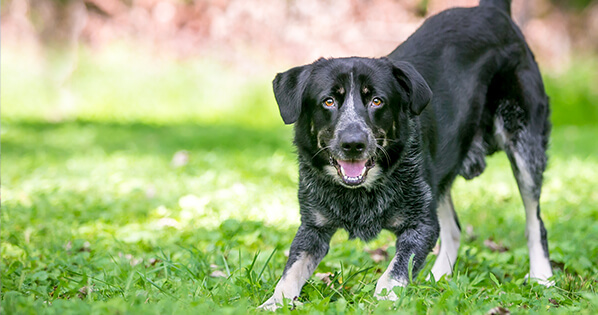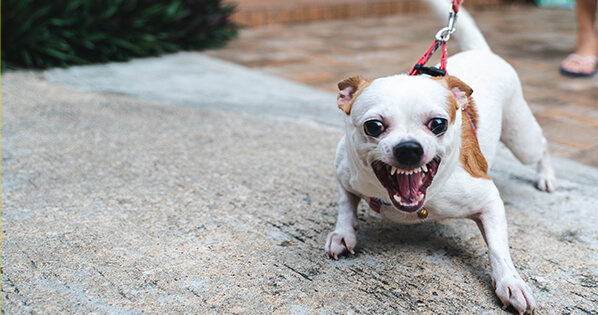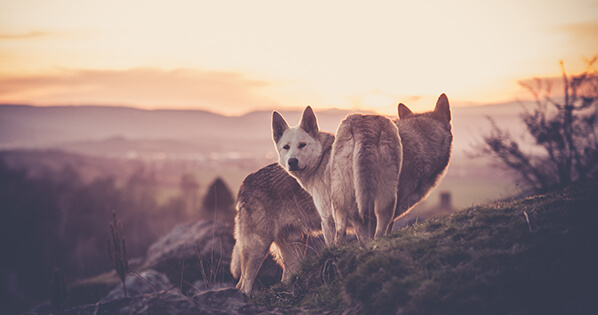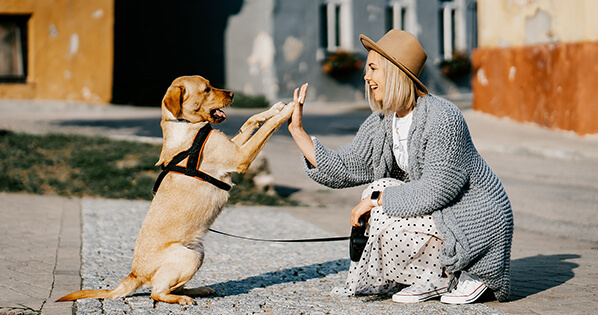
Dogs can show resource guarding over almost anything they value – meals, treats, toys, and even sticks or rocks. When dogs are guarding their food, this is called food aggression and can range anywhere from a minor annoyance to extremely scary and dangerous. Whether your dog shows resource guarding or food aggression towards humans, other dogs, or both, it is important to learn how we can set our dogs up for success rather than making their behavior worse. By understanding why these behaviors occur, how to identify them, and how to fix them, you can create a more peaceful and safe environment for you and your furry friend.
What is food aggression?
Food aggression is when your dog exhibits protective behavior over their meal or treat. This usually consists or baring teeth, growling, snarling, and / or barking. Stiff body language, a rigid tail, and piercing eyes also typically accompany this behavior. In these circumstances, the dog is “claiming” his meal and is letting everyone else know not to come near.
When a dog “claims” either mentally or physically, the territorial reactions we mentioned above begin to appear. These hostile behaviors may escalate into physical damage, so it is important to take them serious and train them immediately.
Although cases range from mild to severe, it is estimated that nearly 20% of all dogs show signs of food aggression. Whether it is towards an adult, a child, a dog, or even a shadow, it is crucial to begin to manage the issue early on, so they do not escalate.
Food aggression in dogs is a prime example of resource guarding.
What is resource guarding?
Resource guarding is a behavior passed down through evolution from ancestor wolves. In a time where these wolves had a hunting success rate of around 5%, every piece of scrap was cherished. Therefore, they evolved to protect every meal or “resource” that they gathered.
The key point of resource guarding is that it describes a defensive or protective behavior of ANY item they consider to be of value, not just food!
Since dogs typically only guard what they deem “valuable”, the items can sometimes vary widely. These can range from food scraps, garbage, bones, toys, or even outdoor things like rocks and grass. Since the protective behavior has the ability to escalate quickly, it is crucial to identify and communicate to any members of the household. Children are especially susceptible, as they may not recognize the signals.
Why is my dog doing this????
Aside from the evolutionary predisposition, your dog may have picked up this behavior in one of these common scenarios:
– As a puppy – These behaviors can develop from a need to compete for resources, as well may have even been accidentally trained by littermates, handlers, or their mother.
– Trauma – If your dog has gone through a significant event- such as a fight, losing a loved one, or abuse – they may develop these issues as a result.
– Breed Disposition – Just like all dogs have the evolutionary background of resource guarding, some breeds have been selectively bred for guarding or protection purposes. These genetics put the dogs at a higher risk to display these hostile behaviors.
– Rescue / Shelter Dogs – These dogs are typically at the highest risk to display these behaviors, as there is often competition for resources like food, water, and beds out in the world (as a stray) and in the shelter system.

OK, well how do I know if it is resource guarding?
The first step to fixing resource guarding or food aggression is to review all the behavioral signs your dog is communicating during the interaction. If you are unsure how to read canine body language, check out this helpful blog to become a master!
While examining the behaviors, be sure to stay calm and follow these rules:
- Do not get too close. Give them their space for right now.
- Do not stare at them in the eyes. This is a sign of competition and will make them feel threatened.
- Do not baby talk them or tell them “it’s ok”. This will only positively reinforce the behavior and teach them do it more.
- Do not try to pet them or interact with them.
- Calmly examine the eyes, ears, teeth, coat, tail, and body posture while periodically looking away. A look away is a great way to signal to the dog “I do not want a fight”. A hard stare does the opposite
- Write down any key behavioral signs you are seeing: teeth bared, piercing eyes, growling, etc.
- Use “look aways” and “lip licks” (periodically licking your lips in a full circle) to soothe your dog and let them know you do not want a fight.
Once you have completed these steps, it is time to figure out where your dog is on the aggression scale:
Mild: Your dog is showing verbal signs of resource guarding and / or food aggression. Your dog may growl when you approach and may also raise their hackles or teeth to serve as a warning.
Moderate: Your dog is showing verbal and physical signs of food aggression. Your dog may snap or lunge when a person or a dog approaches the resource they are guarding.
Severe: Your dog has bitten another dog or human as a result of resource guarding, and they will do anything to keep the threat away.
How do I fix resource guarding and food aggression?
The most important key of fixing and managing resource guarding is to make sure you SET YOUR DOG UP FOR SUCCESS. This means that you should never put them in a situation where they may attack you or another dog as a result of resource guarding. Since you have the skills to now identify the behavior, always remember this moving forward. Do not go into their space and do not stress them out, it will only escalate the behavior and reinforce their defensiveness. Taking it slow is the key to teach them not to feel threatened in these tense situations.
Once you feel comfortable identifying the behavior and managing it, it is time to start the training. The process involves a training program of desensitization and counterconditioning to help teach your dog that you are not a threat to his resource. Start with step one and work your way up gradually, remember…SET THEM UP FOR SUCCESS!
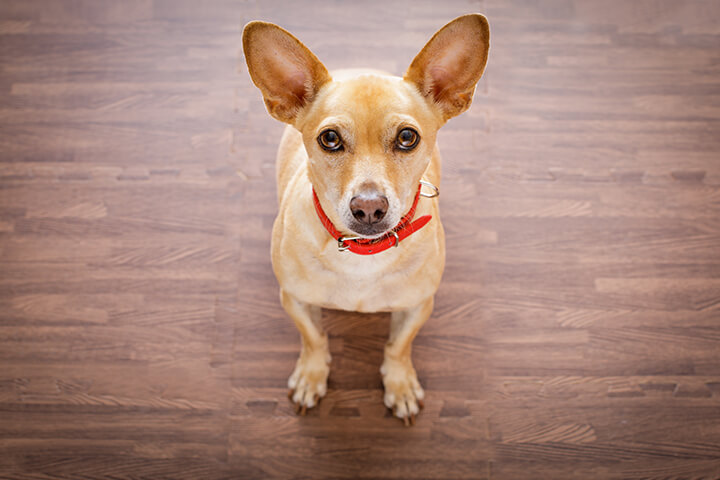
Step one: Desensitizing your dog to human presence while eating
Begin this step by placing your dog’s food on the ground and standing back 3 to 15 feet while they eat their meal. Make note of how close you are to track the progress.
The goal is to start as far away as you need to for your dog to feel comfortable. From there, start moving up a few feet incrementally until you can stand 3 feet away without your dog showing any signs of resource guarding. Move to step two once you are able to stand within 3 feet without any behavioral reaction for 5 meals straight!
PROTIP: This is a great time to start training impulse control! Making them sit and wait before each meal is a great way to control the interaction and begin to train your dog’s impulse control. Start with having them wait for 5 seconds and work up incrementally from there.
Step Two: Desensitizing your dog to stimulus around their bowl
Begin this step by starting at 3 feet and allowing your dog to commence eating after a sit + wait. When you are ready, place a treat near your dog’s bowl. Ideally, you will place it on the ground and not drop it. Place it as far away as you need to in order to not disturb your dog. It is ok if your does not go for the treat, we just want to desensitize them while also offering a reward!
If your dog is showing any signs of resource guarding, back up two feet and continue to drop treats near the bowl. You can toss them or drop them, but placing them on the ground calmly is ideal.
The goal is to begin to place treats within a one-foot radius around the bowl. Once you are able to do this for 5 straight meals, it is time to move to step three!
PROTIP: Do not forget to breathe and keep yourself calm. If you are tense or nervous, your dog will pick up on that energy and may feel more threatened. Stay calm, breathe, and be gentle with your movements and voice.
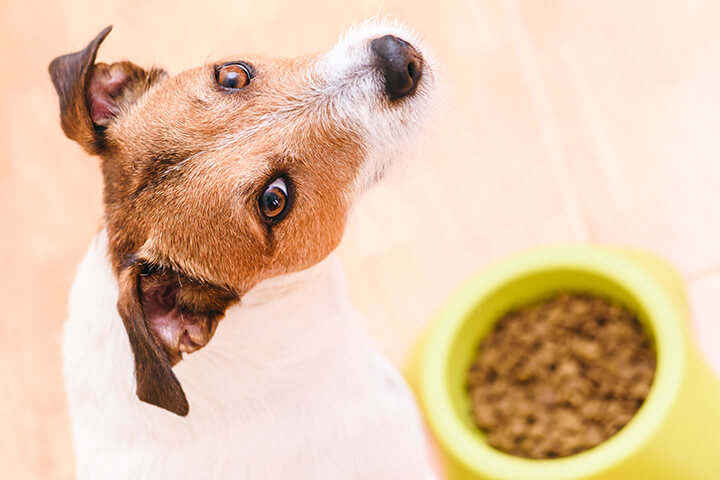
Step Three: Desensitizing auditory and physical stimulation
Begin this step by standing 1 to 3 feet away from your dog and allow them to eat. When you and your dog are both calm, call them by their name in a gentle tone. Do not stare and do not be too loud, speak at a conversational level and show them a treat in your hand. Place your hands towards them and offer the treat. DO NOT invade their personal space and if they show signs of possessive aggression, move your hand away and move back to step two.
If they are interested in the treat, continue to gently say their name, or offer them a dialogue like, “do you want a treat?”. Praise them verbally for any positive body language, and correct them firmly, but softly with “no, ah-ah, easy, etc”. Once they are calm, place the treat into their bowl! You can let them go back to eating and continue to offer them treats periodically during the meal.
Once you are able to place treats in their bowl for 5 meals in a row with no negative body language, you can move to step four!
PROTIP: If you are having trouble, start by gentling tossing them in or around their bowl. Continue to do so until your dog is no longer reacting. From here, start to stand as close as possible to the bowl and drop treats into it. DO NOT move abruptly, and maintain a calm energy. Once you are able to drop treats in, start working on placing them in!
Step Four: Desensitizing physical stimulation and introducing human contact
Begin this step by standing 1 to 3 feet away from your dog and allow them to eat. When you are both calm, reach out your hand as if you were going to drop a treat into their bowl. Instead of dropping it in the bowl, encourage them to take it from your hand. If they take the treat, praise them verbally and calmly back away. Maintain a calm energy (and avoid eye contact) to let them know that you are not interested in their food.
If they are unwilling to take the treat, continue to drop them into the bowl until they are comfortable. Once they can take treats out of your hand for 5 meals in a row, you can move to step 5!
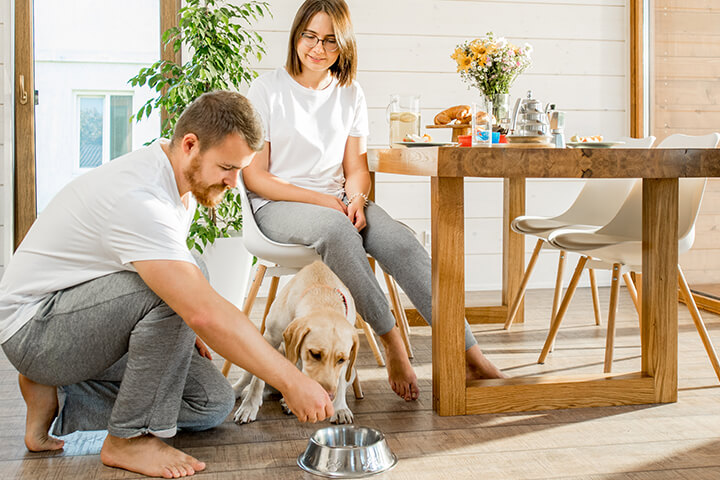
Step Five: Desensitizing physical contact with your dog’s bowl
This step is the same as step four, but with introduction to bowl contact. This time, when you reach down to offer the food, try to calmly place it into their bowl. If your dog in nice and relaxed, place the treat in the bowl and then move away. If your dog continues with no negative body language you can reward them with some praise. Continue to repeat throughout the meal.
Step Six: Practice with family or friends
Now that your dog is getting the hang of it and you have progressed through each five steps, it is time to introduce another human to the training! This should be someone they are already comfortable with, like a friend or family member. Make sure to explain to them the situation and all you have learned from this article before starting step one with them! Work through each step until they can comfortably complete step 5 without any negative body language. Continue to repeat this process at your dog’s pace and with humans they are comfortable with! The more people they get used to around their food or resource, the better!
Now you have all the tools you need to tackle your dog’s food aggression! Make sure to take your time and always pay close attention to your dog’s body language. In addition, be patient with the process and always remind yourself that it will take time! If this step-by-step guide on resource guarding helped you out, drop a comment and let us know! If you are still having issues, feel free to sign up for a free assessment and let us help you!

